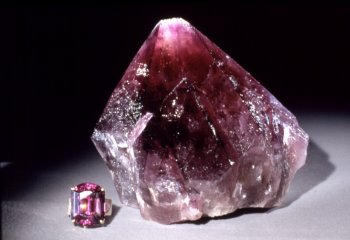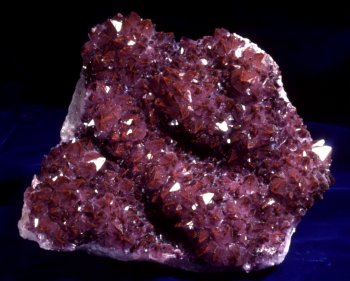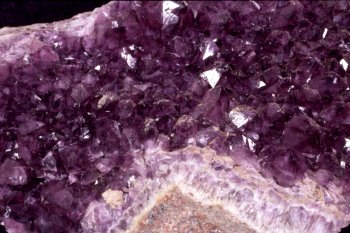 |
|||
|
|||
|
Copyright
Amethyst, Ontario's Mineral Emblem
The name "amethyst" is derived from a Greek word meaning "not drunken" or "sober", reflecting an ancient belief that he who drank wine from an amethyst cup would be protected from overindulgence. According to Greek legend, the god Dionysus, having been insulted by a man, threatened to let loose his tigers upon anyone who henceforth crossed his path. First to arouse his wrath was a young girl on her way to the temple of the goddess Diana. On seeing the tigers coming towards her, the young girl asked the goddess Diana to protect her. Diana responded by changing the girl into rock crystal. Dianysus, ashamed for his cruelty in turning the tigers loose, offered wine to the now-vanished girl. His crystal cup was immediately stained purple by the wine. To this day, the purple color of amethyst has been said to give the mineral the power to prevent drunkenness (Barr 1953). In Biblical times, amethyst was believed to cause lovely dreams and visions (Kunz 1913). It is associated with Bethel, the place of dreams where Benjamin was born. Indeed, the tribe of Benjamin had the honor of having its name engraved on amethyst, and amethyst was one of the twelve minerals adorning the linen bag worn by the High Priest. Amethyst has long been esteemed in ecclesiastical circles, and many fine specimens are set in the rings of bishops.
Ontario adopted the wildflower, trillium, as a floral emblem prior to World War II, and having done so turned its attention in the late 1960s and early 1970s to the possibility of also identifying a mineral emblem. This was partly in recognition of the importance of minerals to the Provincial economy, partly because of the province's growing attraction to domestic and foreign mineral collectors or "rockhounds", particularly in the Bancroft and Lake Superior regions. Amethyst is a variety of the common mineral quartz. Its crystal form (hexagonal pyramidal), its purple colour that symbolises royalty, its hardness and lustre, and its common occurrence in northwestern Ontario but scarcity elsewhere in Canada ideally has qualified it as the Provincial Legislature's choice as a mineral emblem for Ontario. Its selection, however, has not been without controversy.
No doubt the scarcity of the trillium and the economic importance of mining in northern Ontario were the most important factors in the ultimate choice of Thunder Bay amethyst. However, the initiative which culminated in the Mineral Emblem Act came, not from the people of northern Ontario, but from the Bancroft Gem & Mineral Club in Southern Ontario. Knowing of Leo Bernier's sentiments for a mineral emblem, the Bancroft Gem & Mineral Club prepared a submission to the Central Canadian Federation of Mineralogical Societies (CCFMS), urging the latter to recommend Bancroft sodalite as a provincial emblem. In its submission, the Bancroft Gem & Mineral Club stressed that for many years sodalite had been assumed by mineral collectors to actually be Ontario's mineral emblem. Indeed, as early as 1964, it had been referred to as such by C. Grant Waite in an article published in the Lapidary Journal. The club also noted that Ontario is one of the two major sources of sodalite (the other being South Africa), and that, on a Royal visit, Bancroft sodalite had been chosen by Princess Patricia for interior decoration of Marlbororough House, England. On October 24, 1972, Dr. J. Russell Scott, mayor of Belleville, Ontario, forwarded a copy of the Society's proposal to Mr. Bernier. The proposal was again brought to Mr. Bernier's attention by Mrs. Margaret Scrivener, M.P.P. for the Riding of St. David. Mr. Bernier, in turn, referred the matter to the Ontario Geological Survey, of which I happened to be the director at the time, for comment. In my response of February 2, following lengthy discussions with my geologists, I advised Mr. Bernier that the Survey did not favor sodalite, despite its beautiful blue color, as an official emblem for three reasons:
No doubt to Mr. Bernier's delight, it was suggested that consideration be given to alternatives, and I recommended the Ministry solicit submissions from the Royal Ontario Museum and the mineralogy departments of Ontario universities. On 22 February, 1973, again at the Minister's request, my response was followed by a brief discussion of other possible candidates for a mineral emblem, including nepheline, Lake Superior agate, native gold, native silver, and Thunder Bay amethyst. Nepheline, which had been chosen by the CCFMS, was considered unattractive, Lake Superior agate is found not only in Ontario but also on the American side of the International Boundary. Either gold or silver would give recognition to a commercial commodity, and in this context perhaps value of annual production should be a governing factor, and thus it would be more appropriate to recognize Ontario as a "nickel province" by selecting pentlandite, the principal ore mineral found at Sudbury, rather than as a "gold province" or "silver province". Turning to amethyst, I expressed the view that this mineral would be the best choice. First, it is not restricted in occurrence as was sodalite, having been found intermittently over a fairly wide area, from Gunflint Lake to Schreiber in the Lake Superior region. Second, it has a distinctive purple color and excellent crystal form. Third, it occurs in such a way that the best specimens are often obtainable without drilling and blasting. Finally, Ontario ranks with Brazil as a leading source of amethyst in the Canadian market place for mineral collectors. However, I repeated that the Ministry approach other agencies for their recommendations, and concluded by pointing out that his personal choice, "bernierite", was not listed in mineralogy textbooks!
Dr. J.A. Mandarino of the Royal Ontario Museum expressed a different view. In his opinion, "No purpose would be served by such an emblem other than to line the pockets of various commercial types. Minerals are not provincial or even national....and that if either amethyst or sodalite....is selected, great quantities of Brazilian amethyst or South African sodalite will be sold throughout the province as souvenirs of Ontario....which will be as satisfactory as having Expo '67 souvenirs made in Hong Kong. Ontario has produced many mineral species and to single out any one as an official emblem is meaningless." In response to my request for an early reply, as thought was being given to presenting the Queen with a sample of of the new mineral emblem on a forthcoming visit, Dr. Mandarino commented, "If the govenment plans to present the Queen with something mineralogical, why not a small collection reflecting the diversity of Ontario's mineral wealth!" The results of the inquiry, the above comments, and additional suggestions of apatite, scapolite, and cancrinite were transmitted to Mr. Bernier on 4 May, 1973. Despite the comments on the need for, and desirability of a mineral emblem, little time was taken by the Minister to proceed, for on 28 June, the Ontario Geological Survey was asked to make arrangements to have the subject placed on the agenda of the Cabinet's Policy Field Committee unde the chairmanship of Alan Grossman, the Provincial Secretary for Resources Development. On 2 August, 1973, perhaps unwisely as it turned out, I advised the Deputy Minister of potential future embarrassment that could result from the selection of either sodalite or amethyst as an official mineral emblem, again emphasizing that neither mineral was unique to Ontario, and suggesting that because both are of restricted distribution and non-renewable assets, designation of a mineral emblem could compel the government in future years to take conservationist measures to assure long-term public availability. This was particularly true for sodalite, only one occurrence of which was known. An unobtainable mineral emblem would make little sense. It was quite obvious at this stage that any discussion of a mineral emblem by the Policy Field Committee would be heavily weighted toward amethyst from Northern Ontario, a region of which the Minister, Mr. Bernier, represented in the Legislature, rather than Southern Ontario sodalite, for the Ontario Geological Survey was instructed to prepare and publish, as a matter of some urgency, a colorful brochure on the nature and occurrence of amethyst in the Province, including a list of known deposits and commercial outlets. This was obviously in response to pressure from the Thunder Bay amethyst dealers, who must have known in advance, or at least strongly suspected, a Government decision in their favor. In an interview, reported in the 18th January, 1974, issue of the Thunder Bay Chronicle-Journal, Mr. Bernier stated "The decision [in selecting a mineral emblem] was narrowed down to two choices - sodalite from Bancroft and amethyst from Thunder Bay", He further indicated that local amethyst was preferred. In this, it was reported that he was strongly supported by Jack Stokes, a rival National Democratic Party member for Thunder Bay. It was apparent there would be no problems in the Provincial Legislature, and if amethyst were chosen, the proposed Mineral Emblem Act would be passed quickly.
On 25 March, 1975, the Hon. Alan Grossman, following a meeting with representatives of the Thunder Bay Amethyst Mine, requested a report on the nature and occurrence of amethyst, to include "advice from any parties who might appear to have a reasonably objective view concerning one stone or another". This report, by the Ontario Geological Survey, provided the basis for a formal Cabinet submission recommending "amethyst be designated the official stone (sic) of the Province of Ontario". The Cabinet accepted this recommendation on 7 May, 1975, and the decision announced to the press by Mr.Bernier on 14 May. The Mineral Emblem Act received first reading in the Provincial Legislature on 17 June, 1975, and Royal Assent on 8 July. For many years, mineral collectors from the USA and other parts of Canada have visited the Thunder Bay region to search for or purchase samples of amethyst, which still enjoys widespread popularity among this small group of hobbyists. Now, more than two decades after the passage of the Mineral Emblem Act, it is interesting to speculate on the outcome of the designation of amethyst as an official provincial emblem. Many still feel that Bancroft sodalite should have been selected; and I would be remiss if I didn't report that one day after Mr. Bernier made the choice known to the Legislature. A Mr. Hadfield of Brampton, Ontario, drew the Premier's attention to a beautiful variety of green apatite found in the Bancroft area and called "trilliumite" by its co-discoverers Bill Ince and John Shearer. Since the designation of amethyst as Ontario's mineral emblem, increased control by the owners of known deposits may have discouraged collectors' search for samples in the field, and this may have reduced tourism to some degree. But whether or not it has done much to increase sales above the level which would otherwise have been enjoyed; or whether or not it has served to increase the importation of Brazilian amethyst, as predicted by Dr. Mandarino; or whether or not it has resulted in a widespread recognition of a Northern Ontario mineral equal to that of trillium, the floral emblem, remains unanswered. However, the Mineral Emblem Act has drawn the attention of our politicians and many of Ontario's citizens to a formerly little known facet of the Province's mineral heritage. One cannot help but note that one of the most-used committee rooms at Queen's Park in Toronto is called the Amethyst Room, and specimens of amethyst, whatever their source, are found in curio shops all across the Province. Ontario now has only one recognized mineral emblem - the choice of amethyst rather than sodalite or some other mineral has been finalized. No doubt some dissatisfaction remains among collectors of Ontario minerals. But if it is desirable to have an official mineral emblem per se, the Province owes the Bancroft Gem & Mineral Club and Mr. Bernier a debt of gratitude. – Dr. Pye is a professional geologist, who served as the director of the Ontario Geological Survey at the time of the Mineral Emblem Act, 1975.
References:
This article may not be copied, distributed or reprinted in any form without the author's permission. To contact the author, please use the e-mail address provided. If you are unable to contact the author, please contact the Canadian Rockhound. Authorized reprints must acknowledge the author and the Canadian Rockhound, and include the website URL address of the Canadian Rockhound. Figures 1-4 were provided courtesy of the Royal Ontario Museum, © ROM. Figure 5 was reproduced with permission of the Queen's Printer for Ontario, Copyright ©1999. The photographs in this article may not be used on other websites or in other publications without permission. The Canadian Rockhound thanks the Royal Ontario Museum and the Ontario Ministry of Northern Development and Mines for providing the amethyst photos for this article. The Canadian Rockhound also thanks Ruth Debicki and Malcolm Back for their assistance.
|
||

Copyright © 2000 Canadian Rockhound
Magazine Issues |
News & Events |
Junior Rockhound |
Resources
|
||




